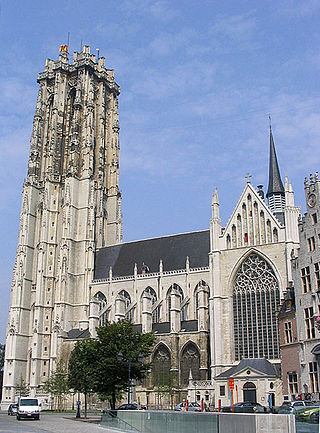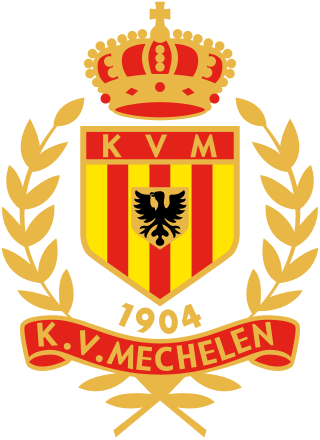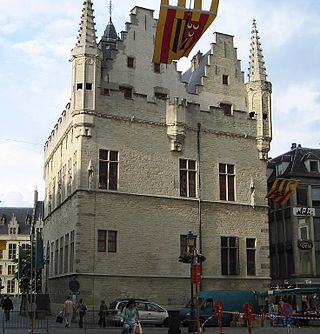
Gorinchem, also spelled Gorkum, is a city and municipality in the western Netherlands, in the province of South Holland. The municipality covers an area of 21.93 km2 (8.47 sq mi) of which 3.10 km2 (1.20 sq mi) is water. It had a population of 37,410 in 2021.

Mechelen is a city and municipality in the province of Antwerp in the Flemish Region of Belgium. The municipality comprises the city of Mechelen proper, some quarters at its outskirts, the hamlets of Nekkerspoel (adjacent) and Battel, as well as the villages of Walem, Heffen, Leest, Hombeek, and Muizen. The river Dyle (Dijle) flows through the city, hence it is often referred to as the Dijlestad.

Dilbeek is a municipality in the province of Flemish Brabant, in the Flemish region of Belgium. The municipality comprises the villages of Dilbeek proper, Groot-Bijgaarden, Itterbeek, Schepdaal, Sint-Martens-Bodegem, and Sint-Ulriks-Kapelle. Dilbeek is located just outside the Brussels-Capital Region in the Pajottenland, hence the local name Poort van het Pajottenland.

Maasmechelen is a municipality located on the Meuse in the Belgian province of Limburg.

St. Rumbold's Cathedral is the Roman Catholic metropolitan archiepiscopal cathedral in Mechelen, Belgium, dedicated to Saint Rumbold, Christian missionary and martyr who founded an abbey nearby. His remains are rumoured to be buried inside the cathedral. State-of-the-art examination of the relics honoured as Saint Rumbold's and kept in a shrine in the retro-choir, showed a life span of about 40 years and a death date between 580 and 655, while tradition had claimed 775 AD.

The Senne or Zenne is a small river that flows through Brussels, Belgium. Its source is in the village of Naast near the municipality of Soignies. It is an indirect tributary of the Scheldt, through the Dyle and the Rupel. It joins the Dyle at Zennegat in Battel, north of the municipality of Mechelen, only a few hundred metres before the Dyle itself joins the Rupel.

Yellow Red Koninklijke Voetbalclub Mechelen, often simply called KV Mechelen or KVM, or by their former French name FC Malinois, is a Belgian professional football club based in Mechelen in the Antwerp province. KV Mechelen plays in the Belgian Pro League. They have won four Belgian championships and twice the Belgian Cup, as well as the 1987–88 European Cup Winners' Cup and the 1988 European Super Cup. They collected most of their honours in the 1940s and in the 1980s.

John Berchmans, SJ was a Jesuit scholastic and is revered as a saint in the Catholic Church.

The Cathedral of St. Michael and St. Gudula, usually shortened to the Cathedral of St. Gudula or St. Gudula by locals, is a medieval Catholic cathedral in central Brussels, Belgium. It is dedicated to Saint Michael and Saint Gudula, the patron saints of the City of Brussels, and is considered to be one of the finest examples of Brabantine Gothic architecture.

Saint Rumbold was an Irish or Scottish Christian missionary, although his true nationality is not known for certain. He was martyred near Mechelen by two men, whom he had denounced for their evil ways.

Antwerpen-Centraal railway station is the main railway station in Antwerp, Belgium. It is one of the most important hubs in the country and is one of the four Belgian stations on the high-speed rail network. From 1873 to early 2007, it was a terminal station. The current building, designed by the architect Louis Delacenserie, was constructed between 1895 and 1905. On 23 March 2007, a tunnel with two continuous tracks was opened under part of the city and under the station. The train services are operated by the National Railway Company of Belgium (NMBS/SNCB).

The Royal Carillon School "Jef Denyn" is a music school in Mechelen, Belgium, that specializes in the carillon. It is the first and largest carillon school in the world. The Belgian government defines it as an "International Higher Institute for the Carillon Arts under the High Protection of Her Majesty Queen Fabiola". The school has trained many of the foremost carillonneurs of the twentieth and twenty-first centuries and houses a rich archive and library.

Belgium's high-speed rail network provides mostly international connections from Brussels to France, Germany and The Netherlands. The high-speed network began with the opening of the HSL 1 to France in 1997, and since then high-speed lines have been extended towards Germany with HSL 2 in 2002, HSL 3 from Liège to the German border in 2009, and HSL 4 from Antwerp to the Dutch border in 2009.

The Arrondissement of Mechelen is one of the three administrative arrondissements in the Province of Antwerp, Belgium. It is both an administrative and a judicial arrondissement, as the territory for both coincides.

Antwerp is a city and a municipality in the Flemish Region of Belgium. It is the capital and largest city of Antwerp Province, and the third largest city in Belgium by area at 204.51 km2 (78.96 sq mi) after Tournai and Couvin. With a population of 536,079, it is the most populous municipality in Belgium, and with a metropolitan population of over 1.2 million people, the country's second-largest metropolitan area after Brussels.

The Spanish Fury at Mechelen was an event in the Eighty Years' War on October 2, 1572 in which the city of Mechelen was conquered by the Spanish army and brutally sacked.

The English Fury at Mechelen or the Capture of Mechelen was an event in the Eighty Years' War and the Anglo–Spanish War on April 9, 1580. The city of Mechelen was conquered by Calvinist rebel forces from Brussels, which included a large contingent of English mercenaries. The city was sacked and many of its religious treasures destroyed or plundered.

The Massacre of Naarden was an episode of mass murder and looting that took place in the Dutch city of Naarden during the Eighty Years' War. The massacre was committed by Spanish soldiers under the command of Fadrique Álvarez de Toledo against the townspeople of Naarden as part of a punitive expedition against Dutch rebels later known as the Spanish Fury. The destruction of the city galvanized the Dutch rebels, leading them to continue the Dutch War of Independence against Spain.

The Schepenhuis of Mechelen, Flemish Brabant, Belgium, is a building where the city's aldermen held their meetings in the Middle Ages. It is located on the edge of the Grote Markt, between the latter and the IJzerenleen and is considered the first stone 'town hall' of Flanders.

The Sack of Lier, also known as the Fury of Lier in the Southern Netherlands, took place on 14 October 1595 when a force of the Dutch States Army led by Charles de Heraugières, governor of Breda, took the town by surprise during the Eighty Years' War. Heraugières, who was known for his daring surprise attacks over Breda in 1590 and Huy in March 1595, had been instructed to capture Lier ahead a small elite force while the bulk of the Spanish Army of Flanders was deployed in northern France and the Lower Rhine. The possession of Lier would have provided the Dutch Republic an advanced base deep inside the Brabant, which would allowed the States troops to cut the communications between Antwerp, Mechelen, Leuven and 's-Hertogenbosch, and to raid as far as Brussels.




















